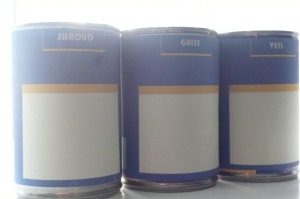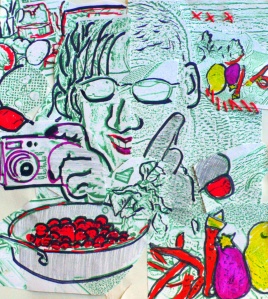Category Archives: AVT 280 Posts
Jeff Soto
Jeff Soto is a younger artist who has an amazing range of illustrations– science fiction, Star Wars, Album Art and Concert posters and toys.
His work is influenced by Robot images, Star Wars droids, and Mr. Potato Head. It has the elements of Robert Williams’ lowbrow art and a sci-fi feel to it, machines come to life. Very interesting work, outside of the page we had assigned, here are to works, one is a map of America covered in fur, and the other is a Star Wars utility droid put out to pasture.
Mariko Mori’s Pureland
What we notice at first in this series is the color and the serene image. The pink dominates and small cartoon figurines float around the woman. The landscape seems unreal and tranquil. The image reminds us of scenery as it appears in Japanese manga and anime. Along with its strong reference to Japanese visual culture, Pureland references Western popular culture such as Hollywood films, as well as landscape painting traditions. draws from both Japanese and Western visual culture.
The sky and water in Pureland have a flatness like that of a computer screen. The widened perspective of Pureland evokes the Japanese concept of sunyata, which can be translated as emptiness. Mori’s lack of depth perspective is disorientating. Even though the image appears tranquil and sweet there is not a lot to keep the viewer engaged. The “flatness” relates to the Japanese ukiyo-e prints from the Edo period. Ukiyo-e originates from a Buddhist concept meaning the “floating world”. In the Edo period the word was associated with woodblock prints. Manga (Japanese graphic novels) and anime (Japanese animated films or television series) can be related back to Hokusai’s range of woodblock prints entitled Manga. Woodblock prints from the Edo period are very close in style to contemporary manga and anime in the use of visual elements such as dark outlines and flatness of representation.
In the unifying glow of Pureland all differences are airbrushed into an uneasy whole. In this way this work mirrors the easily made, disposable Japanese culture–Japan has become both what the West imagines it to be and what it “remembers” to be its national identity.
Martina Lopez- Digital Allegory
Martina Lopez manipulates photographs by combining those of her family with others, by recreating family scenes that may have never existed, and by changing the time place or combination of people to create an alternative reality.
The death of her father and brother gave her the thought of reconstructing memories and exploring feelings of loss. She created works dedicated to her father, mother, and her brother who was killed in Vietnam when she was four years old. Most of her memories of her brother were in part constructed from his presence in family photographs. Lopez writes, “By extracting people from their original context and then placing them into fabricated landscapes, I hope to retell a story of their being, one which allows the images to acquire a life of their own. While the pieces from photographs verify an actual lived experience, the landscape stands as my metaphor for life, demarcating its quality, where the horizon suggests an endless time.”


Aziz & Cucher
The work of these artists begins with the human body, changed and mutated. Identities are erased, the organic parts of the human seem to be disappearing into the void of technology–very uncomfortable to look at but a fascinating combination of organic and synthetic.



GALLERY MAP
Photocopy Portrait
COMMENTS ON DIGITAL TECHNOLOGIES AS A TOOL
1. The text references Walter Benjamin’s essay “the Work of Art in the Age of Mechanical Reproduction”. I researched this essay and found that Benjamin foresaw the potential manipulations of the technology of images—mostly the potential for abuse. Benjamin lived in Europe at the time of World War II and saw the beginning of the use of film and mass media by the Nazi regime. That may have been the reason he seems to object so strongly to mass media and mass reproduction of images.
2. Digital photography and digital images create the “hyper real”. This is changing the basic concept of photography. Photography in its first form captured reality for the masses. Prior to its invention, anything “real” had to be captured and depicted by the person creating the image. Based on their skill, it was close or far from reality. With a camera, the artists now had a level playing field. The text talks about this real now goes into the hyper real, staging, manipulating and seamlessly reconstructing the images.
3. The ability to refine images leads to a “dematerialization” of the natural elements of representation, or at the very least redefines the relationship between nature and the viewer. They use the example of the very detailed scanned image of the butterfly and moth. This made me think of the recent controversy in nature photography—there are now “ranches” where wild animals are housed. The photographer can pay to shoot pictures as wild animals are let out into a natural habitat. Is this the same as hiking into the wild? Should they be valued the same?
4. Although many traditional artists may have some issues with this, there is no doubt that the artists who work in these digital mediums in a “paint” format create some truly awe inspiring work—the image #56. By Chris Finley evokes many of the early abstract expressionist paintings of the early 20th century.
What is uncanny?
The Uncanny (Ger. Das Unheimliche — literally, “un-home-ly”) is a Freudian concept of an instance where something can be familiar, yet foreign at the same time, resulting in a feeling of it being uncomfortably strange.
Because the uncanny is familiar, yet strange, it often creates cognitive dissonance within the experiencing subject due to the paradoxical nature of being attracted to, yet repulsed by an object at the same time. This cognitive dissonance often leads to an outright rejection of the object, as one would rather reject than rationalize.
The word sounded like “Heimlich” as in “maneuver”. Henry Jay Heimlich , M.D. (born Henry Judah Heimlich; February 3, 1920), is an American physician, has received credit as the inventor of abdominal thrusts, also known as the Heimlich maneuver. So, if his family name had been Anglicized, we would all be calling it the Homelike maneuver which does not sound as scientific.
Denis Darzacq
I heard once that the real revenge for Pearl Harbor was McDonalds…not to single them out, but some of the firms like McDonalds, ADM, WalMart, are crowding out smaller companies. In Europe, the supermarket is a realtively new concept. that Darzacq uses humans set against the hypermarket is very effective–are we losing our humanity?
Darzacq asks young street dancers from working class neighborhoods in Paris and Rouen to perform in the aisles of the “hypermarché,” the massive supermarkets and global retail chains that have supplanted smaller shops in France and in many countries around the globe. Suspended in mid-air, these floating bodies bring an otherworldliness to common consumerism. Like baroque figures, the dancers rise and fall either victims or victors against the absolutism of globalized commerce. This opposition between being and having, between the person and the environment – a central theme in Darzacq’s practice – questions the human cost of materialism.
——————————————————————————————————————————————————————————————

Ko
| < |  |
> | ||||||||||
peikin Gallery & De Soto Gallery present






You must be logged in to post a comment.